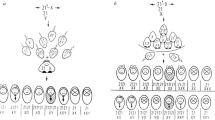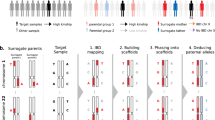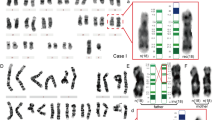Abstract
Microsatellite analysis with 13 microsatellites spread over 18p was performed to determine the origin of the marker chromosome in 9 patients with additional metacentric marker chromosomes. Phenotypes and banding patterns suggested that the markers were isochromosomes 18p. Maternal origin was determined in all 8 cases where both parents were available for study. Six cases showed 3 alleles (one paternal, one maternal each in single and double dose) of informative markers located close to the telomere while markers close to the centromere on 18p were reduced to homozygosity (one paternal allele in single dosage and one maternal allele presumably in triple dosage). A similar result was obtained in the patient with no parents available for examination. The other 2 patients were uninformative for maternal hetero- versus homozygosity, but at some loci the maternal band was clearly stronger than the paternal one whereas the opposite was never observed. Trisomy 18 differs from trisomy 21, XXX and XXY of maternal origin through a preponderance of meiosis II versus meiosis I nondisjunction. Thus, the results of our study and the advanced mean maternal age at delivery of patients with additional i(18p) indicate that in most if not all cases the marker chromosome originates from maternal meiosis II nondisjunction immediately followed by isochromosome formation in one of the 2 maternal chromosomes 18. Possible explanations of these results include a maternally imprinted gene on 18q with a lethal effect if the paternal homologue is lost and a mechanism through which nondisjunction in some cases could be connected with isochromosome formation.
Similar content being viewed by others
Log in or create a free account to read this content
Gain free access to this article, as well as selected content from this journal and more on nature.com
or
References
Schinzel A: Human Cytogenetic Database. Oxford Medical Databases Series. Oxford, Oxford University Press, Electronic Publishing, 1994.
Frøland A, Holst G, Terslev E: Multiple anomalies associated with an extra small autosome. Cytogenetics 1963;2:99–106
Mattel MG, Philip N, Passage E, Moisan JP, Mandel JL, Mattel JF: DNA probe localization at 18p 113 band by in situ hybridization and identification of a small supernumerary chromosome. Hum Genet 1985;69:268–279
Abehovich D, Dagan J, Levy A, Steinberg A, Zlotogora J: Isochromosome 18p in a mother and her child. Am J Med Genet 1993;46:392–393
Uchida IA, Wang HC, Laxdal OE, Zaleski WA, Duncan BP: Partial trisomy-deficiency syndrome resulting from a reciprocal translocation in a large kindred. Cytogenetics 1964;3:81–96
Taylor KM, Wolfinger HL, Brown MG, Chadwick DL: Origin of a small metacentric chromosome: Familial and cytogenetic evidence. Clin Genet 1975;8:364–369
Takeda K, Okamura T, Hasegawa T: Sibs with tetrasomy 18p born to a mother with trisomy 18p. J Med Genet 1989;26:195–197
Schinzel A: A Catalogue of Unbalanced Chromosome Aberrations in Man. Berlin, Walter de Gruyter, 1984.
Schinzel A: Particular behavioural symptomatology in patients with rarer autosomal chromosome aberrations; in Schmid W, Nielsen J (eds): Human Behaviour and Genetics. Amsterdam, Elsevier, 1981, pp 195–210.
Rauch A, Pfeiffer RA, Trautmann U, Liehr U, Rott HD, Ulmer R: A study often small supernumerary (marker) chromosomes identified by fluorescence in situ hybridization (FISH). Clin Genet 1992;42:84–90
Miller SA. Dykes DD, Polesky HF: A simple salting out procedure for extracting DNA from human nucleated cells. Nucleic Acids Res 1988;16:1215.
de la Chapelle A: How do human isochromosomes arise? Cancer Genet Cytogenet 1982;5:173–179
Van Dyke DL, Babu VR, Weiss L: Letters to the editors: Parental age, and how extra isochromosomes (secondary trisomy) arise. Clin Genet 1987;32:76–80
Callen DF, Freemantie CJ, Ringenbergs ML, Baker E, Eyre HJ, Romain D, Haan EA: The isochromosome 18p syndrome: Confirmation of cytogenetic diagnosis in nine cases by in situ hybridization. Am J Hum Genet 1990;47:493–498
Blennow E, Nielsen KB: Molecular identification of a small supernumerary marker chromosome by in situ hybridization: Diagnosis of an isochromosome 18p with probe L1.84. Clin Genet 1991;39:429–433
Robinson WP, Lorda-Sanchez I, Malcolm S, Langlois S, Schuffenhauer S, Knoblauch H, Horsthemke B, Schinzel AA: Increased parental ages and uniparental disomy 15: A paternal age effect? Eur J Hum Genet 1993;1:280–286
Antonarakis SE: Down syndrome study group: Parental origin of the extra chromosome in trisomy-21 as indicated by analysis of DNA polymorphisms. N Engl J Med 1991;324:872–876
Fisher JM, Harvey JF, Morton NE, Jacobs PA: Trisomy 18: Studies of the parents and cell division of origin and the effect of aberrant recombination on nondisjunction. Am J Hum Genet 1995;56:669–675
Schinzel A, McKusick VA. Francomano C: Report of the Committee for Clinical Disorders and Chromosome Aberrations; in Cuticchia AJ (ed): Human Genetic Mapping 1994. A Compendium. Baltimore, The Johns Hopkins University Press, 1995, pp 1017–1071.
Fisher AM, Barber JCK, Crolla JA, James RS, Lestas AN, Jennings I, Dennis NR: Mosaic tetrasomy 8p: Molecular cytogenetic confirmation and measurement of glutathione reductase and tissue plasminogen activator levels. Am J Med Genet 1993;47:100–105
Acknowledgements
This project was supported by the Swiss National Foundation (grant No. 32-37798.93 to AS), The EMBO, Heidelberg (grant to DK) and the Stiftung für wissenschaftliche Forschung an der Universität Zürich (grant to AS). We express our gratitude to all the referring physicians, the patients and their parents.
Author information
Authors and Affiliations
Rights and permissions
About this article
Cite this article
Kotzot, D., Bundscherer, G., Bernasconi, F. et al. Isochromosome 18p Results from Maternal Meiosis II Nondisjunction. Eur J Hum Genet 4, 168–174 (1996). https://doi.org/10.1159/000472191
Received:
Revised:
Accepted:
Issue date:
DOI: https://doi.org/10.1159/000472191
Key Words
This article is cited by
-
Prenatal genetic diagnosis of tetrasomy 18p from maternal trisomy 18p: a case report
Molecular Cytogenetics (2022)
-
Pallister-Killian syndrome: clinical, cytogenetic and molecular findings in 15 cases
Molecular Cytogenetics (2018)
-
Adults with Chromosome 18 Abnormalities
Journal of Genetic Counseling (2015)
-
Tetrasomie 18p
Monatsschrift Kinderheilkunde (2008)
-
De novo isochromosome 18p in a female dysmorphic child
Journal of Applied Genetics (2006)



